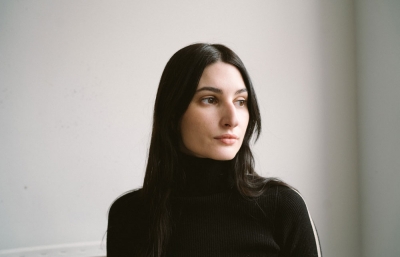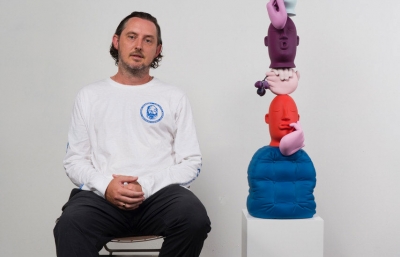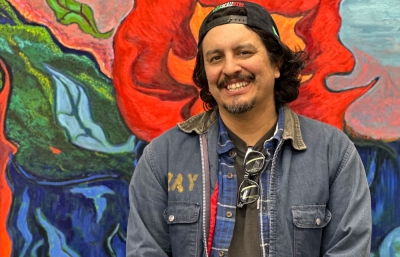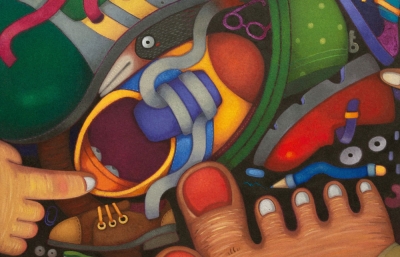Jane Dickson
In the Middle of the Night
Interview by Gwynned Vitello // Portrait by Dondre Stuetley
“I am a pretty literal person… a plainspoken Midwesterner.” Jane Dickson makes comfortable eye contact and speaks in approachable, matter-of-fact cadence, recalling how she didn’t get around to applying for college, but sort of backed into Harvard. Summers in Paris visiting her mother and attending classes at Beaux Arts only reinforced her fascination with defining America, though you won’t find any amber waves of grain in her oeuvre. Without frills or drama, she introduces us to strip clubs, tattoo parlors, casinos and suburban sprawl, often layered in loneliness, but always without judgment, always accompanied by a flicker of ambiguous light.
Gwynned Vitello: From Paris to Harvard, to 43rd Street and 8th Avenue, you officially started your art career by answering a newspaper ad.
Jane Dickson: “Of course, you know how to type?” And, of course, I answered, “Of course!” I left the job interview and immediately went across to a book store and bought Teach Yourself to Type and pounded out all weekend. I’m still not great, but by the time I learned how to use the programs, I learned to fake it. They were happy to get someone willing to give it a try, and I did know about animation. It was very crude— they hadn’t even invented floppy disks, and I remember it was so exciting when we got our first hard drive. It was so crude that I was perfectly equipped for it!

You were assigned the night shift, which led to your first assignments, right?
I would get in at 3:00 or 4:00pm and meet with the salespeople to see what ads I was supposed to work on. Then they would leave and I would be by myself behind the sign. They needed someone there the whole time it was running, to reboot it if it died. I was supposed to be designing ads for the next day or week, so I had a lot of time by myself to think and look out the window. I would go out for my lunch break around 9:00pm and go to this deli that was full of trans people, and it was a whole new world I knew nothing about, a lot more interesting than the still lifes I was setting up in my studio.
All I can think of is crowds and New Year's Eve, and that almost sounds scary. How did it transform at night?
It was fascinating, but yes, scary and repellent, so I think I used photography, and then painting and drawing, as a way to sort of tame what seemed scary. All of New York was so dirty and disgusting at that time, but at night you don’t see garbage as much.
Well, bright lights can transform a city, so they all look pretty at night.
Yeah, almost all you see are the bright lights. So, I was designing animation, white animation on a dark screen, so I started to replicate that with my work, painting canvases and panels black. I had done night street scenes in Boston, but that was looking out of my leaky apartment windows at the rows of parked cars on the street. There was something about the loneliness of nighttime that I was already interested in, so it just made sense to me.

Nighttime exacerbates loneliness, I guess… and a lot of other strong feelings. You have talked about having a fascination with the experience of fear, and I wonder, at this time, was fear connected with physical danger?
Well, I was in the subway and I was alone, and in my apartment, I would block the door. But it’s odd, thinking back, that I didn’t actively worry about being alone; as I said, I’d go and grab a sandwich or coffee. Times Square, however, was not really a place for a young woman, unless, I guess, you were working. People were snatching chains and mugging, so it was not a place to be casual. I’d say I’m just naturally hyper-alert—and curious—which ended up with me carrying a camera and taking pictures. I also started sketching out the window of my office, which was above Times Square. It’s a little triangular building with windows. I had read Baudelaire, and you know, was intrigued with documenting the life of my time.
Ha, I guess I’m fixated on New Year’s Eve, but did you personally witness it there?
I programmed the sign for the New Year’s, I programmed the countdown, which led to me organizing this artist series with my own animation, and it had Keith Haring, David Hammons, Jenny Holzer and a lot of cool artists. I convinced them to let it run right after midnight. After a year or so, my husband Charlie and I moved to a loft on 43rd, just down the street from the sign, so I lived through many New Year’s Eves, which I can say, was not a fun experience—although it led to a whole show of paintings on the subject.
I can imagine the possibilities, so many people desperate to have fun. That is so not my holiday, this intent on being hopeful when the next is just another day.
I ended up being so interested in the idea of a crowd where people feel the need to convey their connection physically, so many people pushing and hanging onto each other. My daughter was born in 1989, so coming into ’90, I had a newborn, as well. My early work was all about loneliness, and this was all about connection. You know, all these people brought their kids and were either pulling them along or ignoring them. And it was about drunkenness, and yeah, sort of this desperation to have fun. I had thought, “Oh, I’ll just put this pillow over my head and wait till it’s over.” We could hear these horns endlessly, and I suddenly realized that I just should just go out and photograph this. If I hate it, I should photograph it. Later, in 2008, I did a big mosaic that’s in the subway, so now there’s this permanent presence of the revelers which came out of that experience.

"I ended up being so interested in the idea of a crowd where people feel the need to convey their connection physically..."
With different clothes and hair, but even in 2008, the crowd was in the same mood.
If you just look at the form of the noisemakers, the horns and hats, they are absolutely Medieval. Now they’re made of cardboard and plastic, but it was people in big, long coats.
I’m imagining masses of people outside of a castle and moat. How different was your work in the casinos, in Vegas? That’s a different shade of aloneness.
Well, that was in 2008, which happened to be another economic bust, so it was totally different. It was kind of deserted. I remember thinking, ugh, that I hated gambling, hated Vegas—just didn’t want to go. An LA friend urged me to go, maintaining it would be great for my work. So I was, like, okay, I’ll go. And then I started taking pictures and realized how fascinating it is. There’s such a sense of disorientation designed into it, the carpet patterns and lights, and nothing is a right angle! Every time I got off the elevator, I thought I’d have my bearings, but no, it’s deliberately designed to obviate all normal guideposts in order to empty your pockets. Like Times Square, it’s an entertainment zone that has a lot of aspiration and heartbreak.
It happened that I was in Florida on the night of a Super Bowl. I wasn’t at the Super Bowl, but I saw this street fair and went back to take photos. Again, it was kind of deserted because all good Floridians were at the game.

Or watching it on TV.
I guess I gravitate to places that are unoccupied, or lightly occupied, where you want to be caught up in the crowd, but are not, and end up in a mode of hesitation, like, I thought this was gonna be really great, but when it’s not full of people… it looks a little tawdry. In my early days, I did a fair amount of time clubbing, but as a participant, I wasn’t there as an observer.
So, when you painted the strippers, you definitely were there as an observer. Did you have a perception of exploitation, or rather, a sense of women owning their bodies?
It’s complicated. I was asked by the writer Guy Trebay to illustrate a four-part series on Times Square, and the last section was on Melody Burlesque. I had never been to a strip club, except for going to the Playboy Club with my dad, which is another weird story. I told my husband, Charlie, that he had to go with me because they didn’t admit single women; they think you’re turning tricks if you’re alone. Melody Burlesque had a little stage, maybe three or four rows of seats on three sides. At this point, it was before plastic surgery was prevalent. So women had all kinds of bodies and they’d come out, one by one. I took photos, which you weren’t supposed to do, but I had a little black Minox that I carried with me all the time. I just sat there and click, click, click. I got a bunch of interesting photos and did drawings from them. Then our building was condemned as a part of the Times Square redevelopment.
Did you want to leave the area?
I had two little kids and the building was full of creeps. I really didn’t want to raise children there, but I did keep my studio for about a year. I really wanted to focus on the heart of Times Square, which is the sex trade. Charlie went with me to Show World, got bounced taking photos and told me that was the last time; I had to figure out other men who would go with me. Because of this, I never had a chance to engage with the strippers. However, I had a friend, Jennifer Cabot, who was stripping her way through her master’s program at Columbia, so she took me to clubs. I spent a lot of time at Filly’s and this bar Tin Pan Alley, which happened to be the focus of that TV show, The Deuce. Other artists worked there, but a bunch of the women came from a much harder life.
Jennifer was, like, “I have a fantastic body, I like to shake it and men hand me lots of money.” She liked the power of it, but I thought it was exploitation. I did the stripper pieces mostly on sandpaper with oil stick, so they had a kind of lipstick quality. The surface is abrasive, but then it’s very juicy, so it’s seductive and repellent at the same time.
I wanted to ask about your use of unexpected surfaces and mix of textures. I hesitate using the word “visceral” because it’s so overused, but your method does produce a very tactile, almost sculptural experience. Isn’t it a lot harder to paint that way?
I like the challenge of figuring it out. Once I’ve gotten too comfortable with a certain set of materials, then I like to switch it up. I find that sometimes, if I go back to something I haven’t used in years, like sandpaper, it’s hard again, and I wonder how in the heck did I do this? When I do things that are fluid, I enjoy it, but then they end up looking like somebody else’s work. I guess mine has to have a certain resistance.

What surface did you use for your carnival series?
The one behind is on black vinyl, but the big ones are on canvas. Often, when I get the bug, I have to use canvas, but, if it’s rough, linen can work. I’m trying to figure out what my next material will be. I’ve got this sample card with all these beautiful felt colors, and am going to order a roll of felt, maybe the blue.
It’s not quite the expectation of New Year’s but going to a carnival involves aspiration, or at least a lot of anticipation.
You go on a ride, and you’re pretty happy afterwards, but there are moments of transcendence. I’ve done a series of ferris wheels, where you’re going up, up, up and you’re at the top… and then it’s over. But then you gotta have another hit. It’s like a drug or something, so it’s not like you end up blissful.
Oh God, more desperation. I’m determined to have fun!
“I’m going to Disneyland and I have to have all my fantasies met.” It’s a place where people are living their lives in public for those moments. I look at other people in groups and perceive a similar, shared dynamic that I think I recognize. Or maybe I’m projecting it on them? Nowadays, I notice people of a certain age. Suddenly I’m noticing grandmas with little grandkids. I look around and see whatever I’m thinking about, and then I paint those people. But I’m not a documentarian. I’m not really doing portraits of people. It’s just an expression, a moment, a feeling that I recognize and identify with—or again, project!
Anything you can share from the show at Southampton Arts?
They did pick one of my drawings to be a poster outside the show. It’s a closeup of this young Black guy. He’s got his baseball cap on backwards, there are fireworks shooting off behind him, and he has this eagerness, you know. He’s this young, attractive person enjoying the fireworks and he’s, like, “Look out word, here I come.” It looks like it should be a portrait of someone famous, but he’s just a guy I happened to catch in a photo. I love this guy’s expression, which is not typical for me. He’s looking straight at you, and he’s sort of ecstatic. I’m not sure why I was so intent on drawing this guy.
Maybe you're projecting, maybe you are excited about becoming a grandma?
I’ve always wanted to do a whole series of fireworks, though I’ve done a few with them in the background. This was one attempt, though, for me, it’s not a theme that has ever quite blossomed.
Jane Dickson will have a solo show with James Fuentes Gallery in NYC in 2022, a traveling exhibition New York Underground: East Village in the ’80s for the Seoul Museum of Art. Juxtapoz will be releasing a series of prints with Jane Dickson on September 16, 2021.






